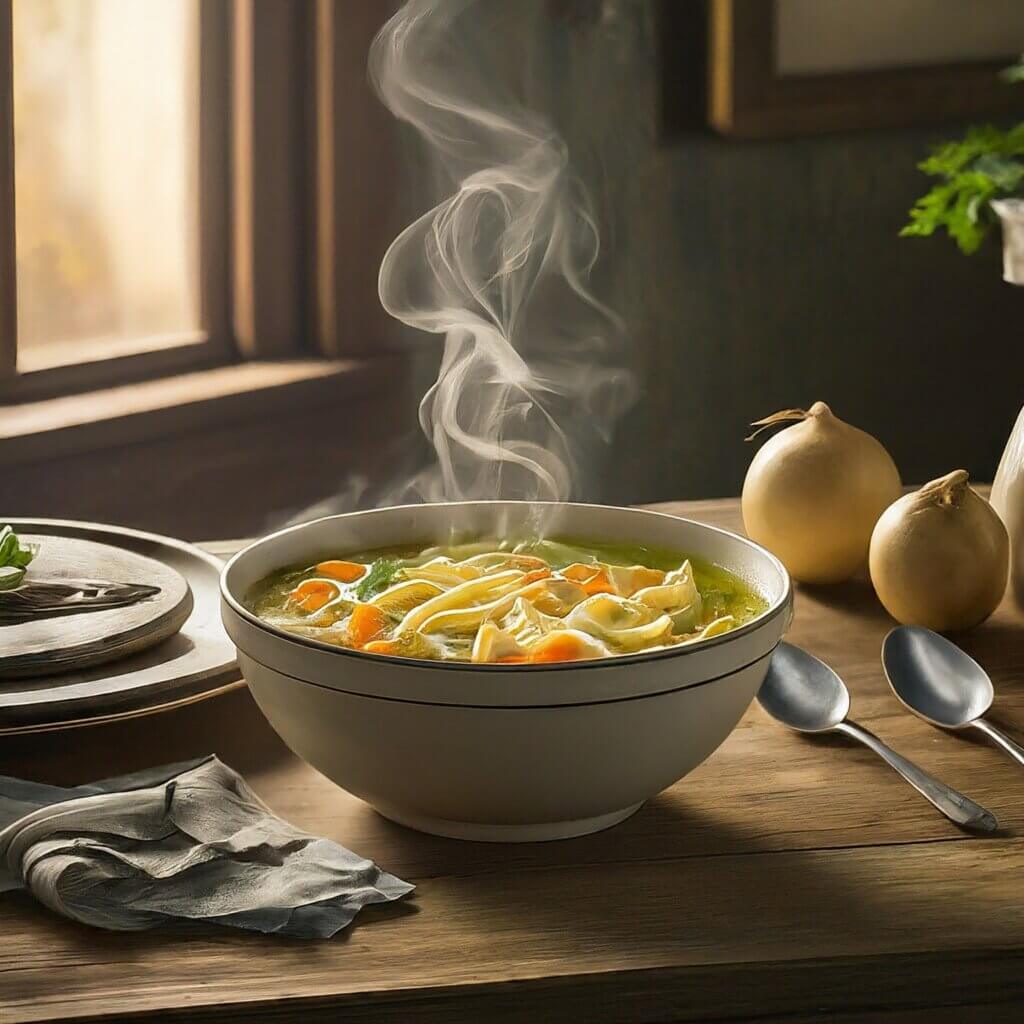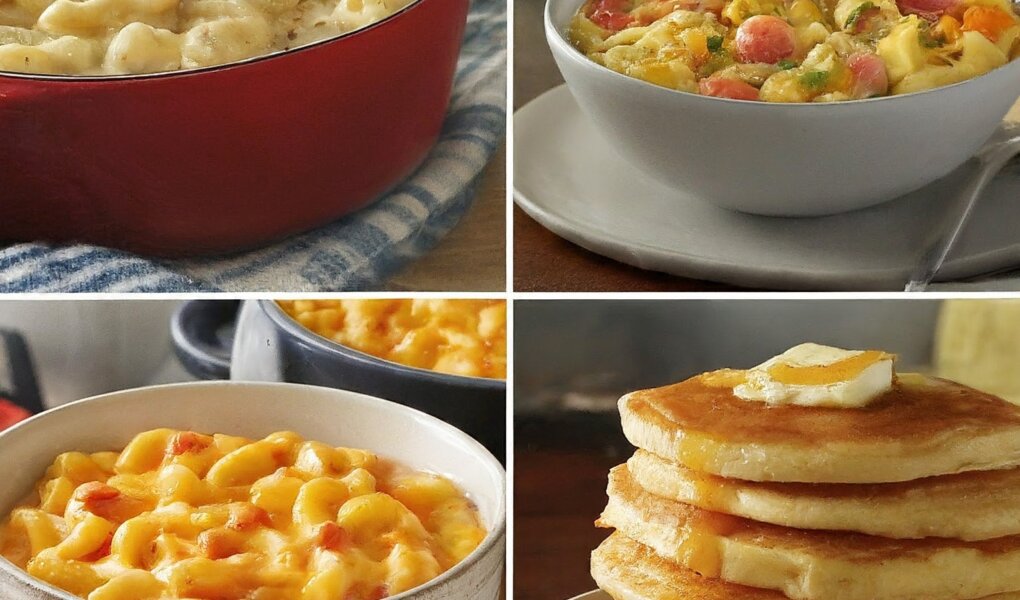
Life throws curveballs, and sometimes, the best antidote to stress or a long day is a plate piled high with comforting, familiar flavors. But who says delicious needs to be complicated? Mastering a handful of these easy comfort food recipes by your mid-twenties can be a lifesaver, offering budget-friendly, soul-warming meals you can whip up on a whim. Not only will these recipes become staples in your kitchen, but the basic techniques you learn can be applied to countless other dishes, fostering a love for cooking that extends far beyond comfort food.
1. The Ultimate Mac and Cheese: A Creamy Canvas for Customization
This creamy, cheesy dish is a universal symbol of comfort. There are endless variations, but a basic recipe with a rich béchamel sauce, melty cheddar, and a touch of mustard powder is a fantastic foundation. You can then customize it with crumbled bacon, roasted vegetables like broccoli or cauliflower, or even a crispy panko topping for a touch of fanciness.
Here’s the magic: Mac and cheese is a fantastic recipe to learn because it introduces you to the fundamentals of roux, a thickening agent made with butter and flour. This basic technique forms the base for countless creamy sauces, from gravies to veloutés. Once you master the roux, you’ll unlock a world of culinary possibilities.
Pro Tip: Don’t overcook your pasta! Aim for al dente, which means “to the tooth” in Italian. This ensures the pasta retains a slight bite and won’t become mushy when coated in the sauce.
2. The Hearty and Healing Chicken Noodle Soup: More Than Just a Cold Remedy
This classic soup is more than just a cold remedy. A simple broth simmered with chicken, vegetables like carrots and celery, and fluffy noodles is both nourishing and deeply comforting. Plus, it’s incredibly versatile! Leftovers can be easily transformed with the addition of leftover roasted vegetables, rice, or even a splash of cream for a richer version.
Chicken noodle soup is a fantastic recipe to learn because it teaches you the importance of building flavor. The key lies in the broth – whether you use store-bought or homemade, it forms the foundation of the entire dish. Learning to build flavor through slow simmering of aromatics like onions, garlic, and herbs will elevate your cooking across the board.
Pro Tip: Don’t discard the leftover cooked chicken! Shred it and use it in salads, sandwiches, or even fold it back into the soup for an extra protein boost.
3. The Weeknight Hero: One-Pan Pasta – A Fuss-Free Feast
This recipe is a dream for busy nights. Simply toss together your favorite pasta, chopped vegetables, protein (sausage, chicken, or chickpeas all work!), and a flavorful sauce in a single pan. Let it all bake together in the oven for a fuss-free, all-in-one meal that’s as easy to clean up as it is to prepare.
One-pan pasta is a great recipe to learn because it introduces you to the concept of sheet pan meals. This method is perfect for busy weeknights, requiring minimal prep work and offering a hands-off cooking experience. It’s also a fantastic way to explore different flavor profiles – try a Mediterranean-inspired version with sun-dried tomatoes and olives, or go for an Asian twist with soy sauce, ginger, and sesame oil.
Pro Tip: Pre-chop your vegetables for even quicker prep time. You can also use frozen vegetables in a pinch, but fresh will offer a more vibrant flavor and texture.
4. The Feel-Good Classic: Grilled Cheese – A Simple Symphony of Cheese and Bread
Few things hit the spot quite like a perfectly golden grilled cheese. Master the art of perfectly melted cheese between buttery toasted bread, and you’ll have a lifelong comfort food at your fingertips. Experiment with different cheeses, add a layer of ham or tomato for extra flavor, or explore variations like a French toast-style grilled cheese dipped in maple syrup for a decadent twist.
The beauty of the grilled cheese lies in its simplicity. However, mastering this dish teaches valuable techniques like proper heat control and achieving even browning. These skills translate well to other cooking methods, like pan-frying meats or searing vegetables.
Pro Tip: Use a sturdy bread that can hold up to the heat and moisture of the cheese, like sourdough or country white. Butter both sides of the bread for an even crispier exterior.
5. The Warm and Fluffy: Pancakes or Waffles – Breakfast for Dinner
Let’s not forget breakfast for dinner! Fluffy pancakes or waffles, drizzled with warm maple syrup and topped with fresh fruit or whipped cream, is a guaranteed mood booster. These breakfast favorites are surprisingly simple to make, requiring just a handful of pantry staples.
Pancakes and waffles are a great recipe to learn because they introduce you to basic leavening techniques. The baking powder or baking soda reacts with the wet ingredients to create air pockets, resulting in the light and fluffy texture we crave. Understanding leavening is crucial for achieving success in countless baked goods, from cakes and muffins to biscuits and popovers.
Pro Tip: Don’t overmix your batter! A few lumps are perfectly fine and will ensure your pancakes or waffles remain light and airy.
Bonus Recipe: The Art of a Simple Salad
While comfort food is all about warmth and indulgence, sometimes a lighter option is desired. Learning to throw together a quick and flavorful salad is a valuable skill to have in your back pocket. Start with a bed of mixed greens, add in chopped vegetables, a protein source like grilled chicken or chickpeas, and top it all off with a simple vinaigrette dressing. Salads are endlessly customizable, allowing you to incorporate seasonal ingredients and explore a variety of flavor profiles.
Beyond Comfort: Building a Culinary Toolkit
These five comfort food recipes are just the beginning of your culinary journey. Mastering them equips you with fundamental techniques and knowledge that can be applied and expanded upon to create countless other dishes. Don’t be afraid to experiment with different flavors and ingredients, and remember, cooking should be enjoyable! Embrace the process, have fun in the kitchen, and most importantly, savor the delicious rewards of your creations.
Meal Prep for Comfort Food
Comfort food doesn’t have to be relegated to occasional indulgences. Here are some meal prep tips to enjoy these favorites throughout the week:
- Double a recipe: When making a pot of soup or a casserole, cook a larger batch and portion it out for future lunches or dinners.
- Cook shredded chicken or ground beef in bulk: Use these pre-cooked proteins in various dishes like pasta, salads, or quesadillas throughout the week.
- Portion out breakfast favorites: Pre-mix pancake or waffle batter and store it in the fridge for quick breakfasts on busy mornings.
FAQs: Comfort Food Recipes Fun Facts and Tips
What are the top 10 comfort foods?
There’s no definitive answer, as comfort food is deeply personal! However, some of the most popular contenders include:
- Mac and Cheese
- Chicken Noodle Soup
- Mashed Potatoes
- Pizza
- Grilled Cheese Sandwich
- Chocolate Chip Cookies
- Fried Chicken
- Spaghetti and Meatballs
- Lasagna
- Pancakes or Waffles
What foods are considered comfort foods?
Comfort foods are generally dishes associated with feelings of nostalgia, warmth, and satisfaction. They often involve simple preparations, familiar flavors from childhood, and evoke positive memories.
What are British comfort foods?
The UK boasts its own set of comforting classics, including:
- Bangers and Mash (sausages with mashed potatoes)
- Fish and Chips
- Shepherd’s Pie (ground lamb with mashed potato topping)
- Toad in the Hole (sausages baked in a Yorkshire pudding)
- Sticky Toffee Pudding
Why is pizza a comfort food?
Pizza ticks many comfort food boxes! It’s often associated with happy occasions like birthday parties or movie nights. The warm, doughy base, melty cheese, and variety of toppings offer a satisfying and customizable experience.
Why is food called comfort food?
Food is called comfort food because it provides more than just physical nourishment. It taps into our emotions and memories, offering a sense of security, nostalgia, and well-being. Here’s a breakdown of the key factors:
- Nostalgia: Comfort foods are often linked to positive memories from childhood, like grandma’s mac and cheese or the warm bowls of soup Mom made when we were sick. These familiar flavors transport us back to a time of feeling safe, loved, and cared for.
- Emotional Connection: The act of eating comfort food can be a form of self-care. The rich textures, comforting flavors, and familiar aromas can trigger the release of pleasure hormones like dopamine, creating a sense of relaxation and reducing stress.
- Psychological Comfort: Comfort foods are often high in carbohydrates, sugar, or fat. While not the healthiest choices in excess, these macronutrients can provide a temporary feeling of comfort and satisfaction. The act of consuming these foods can be almost meditative, allowing us to focus on the sensory experience and take a break from daily stressors.
Why is comfort food so good?
Comfort food hits the spot on multiple levels. It combines:
- Familiar Flavors: We naturally gravitate towards tastes and textures we associate with positive experiences. Comfort food provides a sense of security and predictability, offering a break from culinary exploration.
- Sensory Experience: The combination of aroma, texture, and taste plays a significant role in our enjoyment of food. Comfort foods often boast rich, creamy textures, gooey cheeses, and satisfying carbohydrates – a sensory experience that triggers feelings of pleasure.
- Emotional Connection: As mentioned earlier, comfort food transcends simple sustenance. It provides a bridge to happy memories and a sense of emotional security.
Remember, you don’t have to be a master chef to enjoy cooking. These comfort food classics are a springboard for building your culinary confidence. So, put on an apron, crank up the music, and get ready to create delicious memories in the kitchen.



